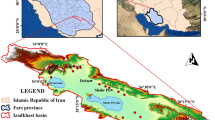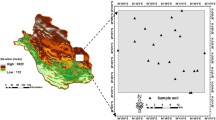Abstract
Soil salinization is a serious environmental problem in the world, especially in arid and semi-arid regions. Therefore, estimating spatial variability of soil salinity plays an important role in environmental sciences. Aiming at the problem of soil salinization inside an oasis, a case study was carried out at the Sangong River catchment in Xinjiang province, northwest China. Methods of classical statistics, geostatistics, remote sensing (RS) and geographic information system (GIS) were applied to estimate the spatial variability of soil salt content in the topsoil (0–20 cm) and its relationship with landscape structure at catchment scale. The objective of this study was to provide a scientific basis to understand the heterogeneous of spatial distribution of soil salt content at a large scale. The results revealed that (1) elevation of landform was a key factor for soil salt content’s spatial variability, and soil salt content had a strong spatial autocorrelation, which was mainly induced by structural factors. (2) Mapping of soil salt content by Kriging and comparing it with landscape maps showed that area of soil salinization in old oasis was smaller than that in new oasis, and degree of soil salinization in old oasis was also lower than that in the new one. Among all landscapes, cropland was mostly affected by salinity, with 38.8% of the cropland in new oasis moderately affected by soil salinity, and 8.54% in old oasis.






Similar content being viewed by others
References
Amezketa E (2006) An integrated methodology for assessing soil salinization, a pre-condition for land desertification. J Arid Environ 67:594–606
Barbizzi S, Zorzi PD, Belli M, Pati A, et al (2004) Characterization of a reference sit for quantifying uncertainties related to soil sampling. Environ Pollut 127:131–135
Benyamini Y, Mirlas V, Marish S, Gottesman M, Fizik E, Agassi M (2005) A survey of soil salinity and groundwater level control systems in irrigated fields in the Jezre’el Valley, Israel. Agric Water Manage 76:181–194
Bocco G, Mendoza M, Velazquez A (2001) Remote sensing and GIS-based regional geomorphological mapping: a tool for land use planning in developing countries. Geomorphology 39:211–219
Campbell JB (1978) Spatial variation of sand content and ph with in single contigous delineation of two soil mapping units. Soil Sci Soc Am J 42:460–464
Castrignano A, Maiorana M, Fornaro F, Lopez N (2002) 3D spatial variability of soil strength and its change over time in a durum wheat field in southern Italy. Soil Tillage Res 65:95–108
Chien YJ, Lee DY, Guo HY, Houng KH (1997) Geostatistical analysis of soil properties of mid-west Taiwan soils. Soil Sci 162:291–297
Corwin DL, Lesch SM (2005) Characterizing soil spatial variability with apparent soil electrical conductivity I. Survey protocols. Comput Electron Agric 46:103–133
Corwin DL, Lesch SM, Oster JD, Kaffka SR (2006) Monitoring management-induced spatio-trmporal changes in soil quality through soil sampling directed by apparent electrical conduction. Geoderma 131:369–387
Fang HL, Liu GH, Kearney M (2005) Georelation analysis of soil type, soil salt content, landform, and land use in the Yellow River delta. Environ Manage 35:72–83
Flowers TJ, Flowers SA (2005) Why does salinity pose such a difficult problem for plant breeders? Agric Water Manage 78:15–24
Goovaerts P (1999) Geostatistics in soil science: state-of-the-art and perspectives. Geoderma 89:1–45
Gu FX, Zhang YD, Pan XL (2003) Interaction of land use change and spatial and temporal dynamics of soil moisture and salinity in arid land. Acta Geogr Sin 58(6):845–853
Guo ZhR, Liu HT (2002) Secondary salinification of soil and dynamic control of groundwater in irrigation area of inland basin, northwestern China. Agro-environ Prot 21(1):45–48
Han DL (2001) Artificial oases of Xinjiang. Chinese Environmental Sciences Press, Beijing, pp 21–32
Herrero J, Pe´rez-Coveta O (2005) Soil salinity changes over 24 years in a Mediterranean irrigated district. Geoderma 125:287–308
Hillel D (1991) Research in soil physics: a review. Soil Sci 151:30–34
Jordán MM, Navarro-Pedreño J, García-Sánchez E, Mateu J, Juan P (2003) Spatial dynamics of soil salinity under arid and semi-arid conditions: geological and environmental implications. Environ Geol 45(4):448–456
Lamsal K, Paudyal GN, Saeed M (1999) Model for assessing impact of salinity on soil water availability and crop yield. Agric Water Manage 41:57–70
Lesch SM (2005) Sensor-directed response surface sampling designs for characterizing spatial variation in soil properties. Comput Electron Agric 46:153–179
Lesch SM, Rhoades JD, Lund LJ, Corwin DL (1995) Mapping soil salinity using calibrated electromagnetic measurements. Soil Sci Soc Am J 56:540–548
Li HB, Reynolds JF (1995) On definition and quantification of heterogeneity. Oikos 73:280–284
Li HB, Wang ZhQ, Wang QCh (1998) Theory and methodology of spatial heterogeneity quantification. Chin J Appl Ecol 9(6):651–657
Li YY, Zhang FH, Pan XD, Chen F, Lai XQ (2007) Changes of salt accumulation in soil layers with different landforms in Manas River valley in Xinjiang region of China. Trans CSAE 23(2):60–64
Liu H, Zhong HP, Gu Y (2001) Water resources development and oasis evolution in inland river basin of arid zone of northwest china. Adv Water Sci 9(3):378–384
Mahmood K, Morris J, Collopy J, Slavich P (2001) Groundwater uptake and sustainability of farm plantations on saline sites in Punjab province, Pakistan. Agric Water Manage 48:1–20
O’Hara SL (1997) Irrigation and land degradation: implications for agriculture in Turkmenistan, central Asia. J Arid Environ 37:165–179
Okina GS, Gilletteb DA, Herrickc JE (2006) Multi-scale controls on and consequences of aeolian processes in landscape change in arid and semi-arid environments. J Arid Environ 65:253–275
Robertson GP (2000) Geostatistics for environmental sciences: GS+ user’s guide, Version 5. Gamma Design Software, MI, pp 200
Sepaskhah AR, Ahmadi SH, Shahbazi AR (2005) Geostatistical analysis of sorptivity for a soil under tilled and no-tilled conditions. Soil Tillage Res 83:237–245
Sylla M, Stein A, van Breemen N, Fresco LO (1995) Spatial variability of soil salinity at different scales in the mangrove rice agro-ecosystem in West Africa. Agric Ecosyst Environ 54:1–15
Thomas DSG, Middleton NJ (1993) Salinization: new perspectives on a major desertification issue. J Arid Environ 24:95–105
Utset A, Borroto M (2001) A modeling-GIS approach for assessing irrigation effects on soil salinisation under global warming conditions. Agric Water Manage 50:53–63
Valle HF DEL, Elissalde NO, Gagliardini DA, Milovich J (1998) Status of desertification in the Patagonian region: assessment and mapping from satellite imagery. Arid Soil Res Rehabil 12:95–122
Wang LP (1998) Synthetic analysis for extracting information on soil salinity using remote sensing and GIS: a case study of Yanggao basin in China. Environ Manage 22(1):153–159
Wang ZhQ (1999) Geostatitics and its application in ecology. Science Press, Beijing, pp 150–189
Wang YG, Xiao DN, Li Y, Li XY (2007) Soil salinity evolution and its relationship with dynamics of groundwater in the oasis of inland river basins: case study from the Fubei region of Xinjiang Province, China. Environ Monit Assess. doi:10.1007/s10661-007-9867-z
Webster R (1985) Quantitative spatial analysis of soil in the field. Adv Soil Sci 3:1–70
Weisbrod N, Dragila MI (2006) Potential impact of convective fracture venting on salt-crust buildup and ground-water salinization in arid environments. J Arid Environ 65:386–399
Wilson EH, Sader SA (2002) Detection of forest harvest type using multiple dates of Landsat TM imagery. Remote Sens Environ 80:385–396
Yan JF, Chen X, Luo GP, Guo QJ (2006) Temporal and spatial variability response of groundwater level to land use/land cover change in oases of arid areas. Chin Sci Bull 51(Supp I):51–59
Zhang CS, McGrath D (2004) Geostatistical and GIS analyses on soil organic concentrations in grassland of southeastern Iseland from two different periods. Geoderma 119:261–275
Zhang RS, Rahman GFV, Munn LC (1995) Geostatistical analyses of trace elements in soil and plants. Soil Sci 159:383–390
Zhang H, Wu JW, Zheng QH, Yu YJ (2003) A preliminary study of oasis evolution in the Tarim Basin, Xinjiang, China. J Arid Environ 55:545–553
Zhao CY, Wang YC, Song YD, Li BG (2004) Biological drainage characteristics of alakalized desert soils in north-western China. J Arid Environ 56:1–9
Acknowledgments
This research is sponsored by the Knowledge Innovation project of the Chinese Academy of Science (No. KZCX2-YW-431) and the National Natural Science Foundation of China (No. 40701187). The authors are grateful to the reviewers for their helpful comments and suggestions to improve the manuscript.
Author information
Authors and Affiliations
Corresponding author
Rights and permissions
About this article
Cite this article
Wang, Y., Li, Y. & Xiao, D. Catchment scale spatial variability of soil salt content in agricultural oasis, Northwest China. Environ Geol 56, 439–446 (2008). https://doi.org/10.1007/s00254-007-1181-0
Received:
Accepted:
Published:
Issue Date:
DOI: https://doi.org/10.1007/s00254-007-1181-0




